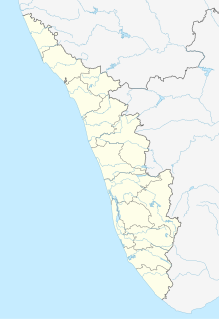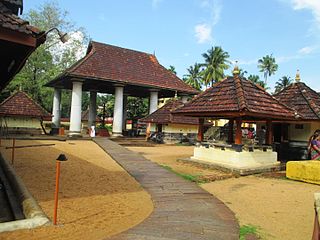
Thrissur, also known by its former name Thrissivaperur, is a city and the headquarters of the Thrissur district in Kerala, India. It is the third largest urban agglomeration in Kerala after Kochi and Calicut urban areas and the 21st largest in India. It is famous for the Thrissur Pooram festival.

'Kerala mural paintingsare the frescos depicting Hindu mythology and legends, which are drawn on the walls of temples and churches in South India, principally in Kerala. Ancient temples and palaces in Kerala, [[South India], display an abounding tradition of mural paintings mostly dating back between the 9th to 12th centuries CE when this form of art enjoyed royal patronage. Latterly, Christian churches near BVM college Cherpunkel in Kerala have commissioned mural paintings with Christian subjects in the local style. The scriptural basis of these paintings can be found in the Sanskrit texts, 'Chithrasoothram - Tantrasamuchaya, the fifteenth century text authored by Narayanan, Abhilashitartha Chintamani of the twelfth century and Silparatna by Sreekumaran of the sixteenth century. Iconography of the mythological character in murals are based on the Dhyanaslokas.

Vadakkumnathan Temple is an ancient Hindu temple dedicated to Shiva at city of Thrissur, of Kerala state in India. This temple is a classical example of the architectural style of Kerala and has one monumental tower on each of the four sides in addition to a kuttambalam. Mural paintings depicting various scenes from the Mahabharata can be seen inside the temple. The shrines and the Kuttambalam display vignettes carved in wood. The temple, along with the mural paintings, has been declared as a National Monument by India under the AMASR Act. According to popular local lore, this is the first temple built by Parasurama, the sixth avatara of Vishnu. Thekkinkadu Maidan, encircling the Vadakkunnathan Temple, is the main venue of the renowned Thrissur Pooram festival.

Cheruthuruthy also known as Vallathol Nagar is a small town in India near Wadakkanchery, Thrissur on the banks of the Nila (Bharathapuzha) river.

Thrissur is a district of Kerala situated in the central part of that state. Spanning an area of about 3,032 km2 (1,171 sq mi), Thrissur district is home to over 9% of Kerala's population.

The Mattancherry Palace is a Portuguese palace popularly known as the Dutch Palace, in Mattancherry, Kochi, in the Indian state of Kerala which features Kerala murals depicting portraits and exhibits of the Rajas of Kochi. The palace was included in the "tentative list" of UNESCO World Heritage Site.

Sittanavasal Cave is a 2nd-century Jain complex of caves in Sittanavasal village in Pudukottai district of Tamil Nadu, India. Its name is a distorted form of Sit-tan-na-va-yil, a Tamil word which means "the abode of great saints".

Thirunandikkara Cave Temple, also referred to as Thirunanthikarai rock-cut Shiva temple, is a 9th-century rock-cut Hindu cave temple in Kanyakumari district, Tamil Nadu, India. It is dedicated to Shiva, with murals and inscriptions. It is attributed to the Ay king Vikramaditya Varaguna by Archaeological Survey of India, but to Pandya rulers (Nedunjadaiyan) a few decades earlier by Ajit Kumar, an archaeologist. It is part of a larger active temple complex named the Thirunanthikarai Shri Nandeeswara temple, Thirunanthikarai and is carved out of the side of a rocky hillock to the north of the temple complex. According to Rao, one of the inscriptions suggests that this may be a late 8th-century cave temple or early 9th.

Thrissur is the administrative capital of Thrissur District situated in the central part of Kerala state, India. Thrissur district was formed on 1 July 1949. It is an important cultural centre, and is known as the Cultural Capital of Kerala. It is famous for the Thrissur Pooram festival, one of the most colourful and spectacular temple festival of Kerala. From ancient times, Thrissur has played a significant part in the political, economical and cultural history of Indian sub continent and South East Asia. It has opened the gates for Arabs, Romans, Portuguese, Dutch and English. Thrissur is where Christianity, Islam and Judaism entered the Indian sub continent, when Thomas the Apostle arrived in 52 CE and the location of country's first Mosque in the 7th century.

Pundareekapuram Temple is a small Hindu temple atop a little rise called Midayikunnam near Thalayolaparambu in Kottayam. Architecturally it is not very different from any typical village temple of Kerala. A tiled and saddle roofed square "Chuttambalam" encloses a square sanctum sanctorum. Appended to the square enclosure is a small ‘balikkalpura’. The idol worshipped here is the image of Vishnu sitting astride his celestial vehicle Garuda together with Bhoodevi. This is a rare icon.

Wadakkancherry is a major town in Thrissur, Kerala. Up until 1860, this area was part of Chelakkara Taluk. Now, it is the headquarters of Talappilly Taluk.
Thirunanthikarai is a village situated in Thirparappu panchayath, in the Kanyakumari district of Tamil Nadu, India. This village comes under the post office of Kulasekharam, 3 km away, and is located along the Kulasekharam–Pechiparai road.

Ramavarmapuram is the northern suburb of Thrissur City in Kerala. This suburban area is home to several governmental and other institutions of national importance. The largest menhir type megalithic monument in granite in Kerala is found here. A local catholic church has recently been adorned with mural paintings in the traditional Kerala style. This is the first instance of such a church decoration in Kerala in modern times.

ThiruvanchikulamSivaTemple is a Hindu temple situated in Kodungallur in Thrissur district in the South Indian state of Kerala in India. Constructed in the Kerala style of architecture, the temple is believed to have been built during the Chera period in the 8th century. Shiva is worshipped as Mahadeva and his consort Parvathi as Umadevi.

Ettumanoor Mahadeva temple is an ancient Shiva temple in Kottayam, Kerala, India. Temple tradition has it that the Pandavas and the sage Vyasa had worshipped at this temple. The name of the place has its origin from the word manoor, which means "the land of deer." The temple is one of the major Shiva temples in Kerala, along with Vaikom Temple, Chengannur Mahadeva Temple, Kaduthruthy Mahadeva Temple, Ernakulam Shiva Temple, Vazhappally Maha Siva Temple and Vadakkunathan temple.

Archaeological Museum, Thrissur is an art and archaeological museum situated in Thrissur City of Kerala state, India. The museum is located in the Thrissur Zoo compound.

The Krishnapuram Palace is a palace and museum located in Kayamkulam near Alappuzha in Alappuzha district, Kerala in southwestern India. It was built in the 18th century by Anizham Thirunal Marthanda Varma, the Travancore kingdom. It is built in the architectural style of Kerala with gabled roof, narrow corridor and dormer windows, near the Krishnaswamy Temple at Krishnapuram.

Mathur Shiva Temple is a Hindu temple located in Kunnamkulam of Thrissur District of India. It is believed that the Siva linga is Rudrakshasila which is irregular in shape, red in colour and is untouched by the human sculptor. The presiding deity of the temple is Shiva located in main Sanctum Sanctorum, facing West and Lord Parvathi located in same Sanctum Sanatorium, facing East. According to folklore, sage Parashurama has installed the idol. The temple is a part of the 108 famous Shiva temples in Kerala.

Chowannur is a place in Thrissur district, state of Kerala, India.



















